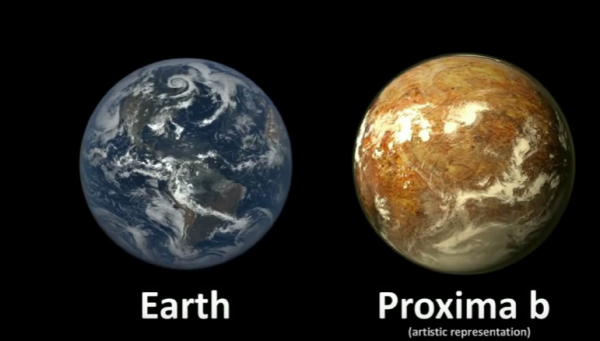By Staff Reporter, | October 14, 2016

An artistic Representation of Proxima b.
Earlier in August, astronomers announced the discovery of an Earth-like exoplanet. The planet named Proxima b is orbiting the Proxima Centauri and is 4.25 light years away from Earth.
From the early findings, it seems the planet is rocky like the Earth and is located at an optimum distance from its star to sustain liquid water and life also known as the circumstellar habitable zone. Further evidence also suggests that the planet could be well covered in oceans of liquid water. The discovery of Proxima b holds great significance as the previous closest known Earth-like exoplanet is 14 light years away, Wolf 1061 c.
Like Us on Facebook
However, all is not rosy as it seems. The Universe Today reported on a study conducted by the Pale Red Dot team on Proxima b. According to the research team, Proxima b is revolving around its red dwarf star at approximately one-tenth of the distance between the sun and Mercury. With temperature variation of -173 C - 427 C, Mercury is not a planet that seems to be capable of holding liquid water. It is highly probable that Proxima b could be tidally locked to its star, resulting in the planet facing the star. Add to this, the radiation received by Proxima b from its red dwarf star would be much greater than what we are used to n our dear Earth.
But it is not all gloomy, Science Alert reported about a team of scientists from the University of Marseilles and the Carl Sagan Institute who have done some scientific calculations and developed models. According to them, Proxima b in all probability has more than 50 percent of water thus can be considered an "ocean planet."
Most research conducted so far are based on the assumption that Proxima b is similar to the planets found in our Solar system. To know for sure, if Proxima b is habitable or not, we need to have some actual data transmitted from a spacecraft or device.
For now, we can hope that when the real data comes from the exoplanet Proxima b, it looks as promising as the current theories.
-
Use of Coronavirus Pandemic Drones Raises Privacy Concerns: Drones Spread Fear, Local Officials Say

-
Coronavirus Hampers The Delivery Of Lockheed Martin F-35 Stealth Fighters For 2020

-
Instagram Speeds Up Plans to Add Account Memorialization Feature Due to COVID-19 Deaths

-
NASA: Perseverance Plans to Bring 'Mars Rock' to Earth in 2031

-
600 Dead And 3,000 In The Hospital as Iranians Believed Drinking High-Concentrations of Alcohol Can Cure The Coronavirus

-
600 Dead And 3,000 In The Hospital as Iranians Believed Drinking High-Concentrations of Alcohol Can Cure The Coronavirus

-
COVID-19: Doctors, Nurses Use Virtual Reality to Learn New Skills in Treating Coronavirus Patients







